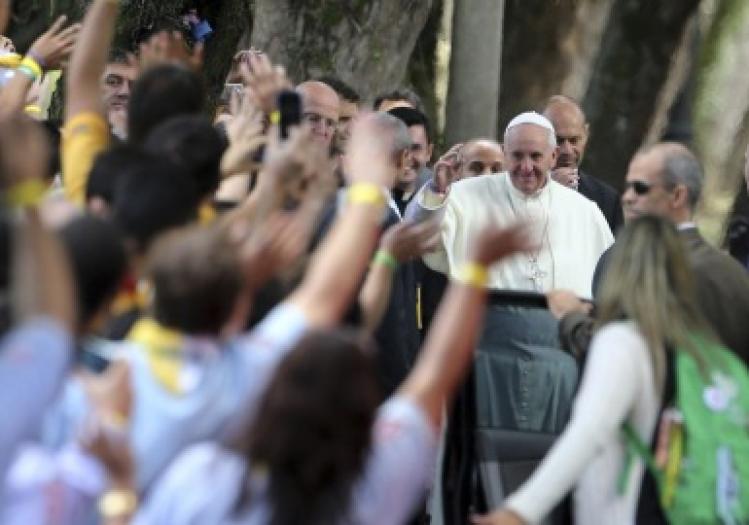
Decretal letters, encyclicals, apostolic exhortations, allocutions, apostolic constitutions, the motu proprio, papal homilies, and addresses we have had in abundance over the past two hundred years. We have also had radio addresses, tweets, and book-length conversations such as Pope Benedict’s 2010 Light of the World with journalist Peter Seewald. Since Pope Francis’s election his own Argentinian conversations with Rabbi Abraham Skorka have been published as On Heaven and Earth. Previously, Rabbi Skorka wrote the prologue to El Jesuita, a book of interviews Cardinal Bergoglio published in 2010.
Over the past two months, Pope Francis has begun to fashion from the interview/conversation form a new genre of papal pronouncement, minimally authoritative, but unprecedented in its reach. It began with the pope perched over the back of an airline seat engaging reporters on the flight back from Rio de Janeiro in August. It continued in Rome with his lengthy interview with Antonio Spadaro, S.J. of Civiltà Cattolica that appeared in English in America on September 19. Within two weeks, La Repubblica published editor Eugenio Scalfari’s account of his September 24 conversation with Pope Francis. This conversation followed up on a lengthy letter the pope wrote Scalfari on September 4, responding to an open letter Scalfari wrote after reading the encyclical Lumen Fidei. Scalfari’s piece was quickly translated into English. We could call this new genre the papal news media interview.
In the give and take of conversation, Pope Francis’s ad hoc interviews play off his interlocutors. From Skorka to Spadaro to Scalfari, he does not fear to give up full control and places himself in their hands. The in-flight interview had the highest degree of spontaneity, while Spadaro heavily edited the Jesuit interview. Amazingly, the conversation with Scalfari appears in the latter’s own redaction. Despite variations, the three papal interviews to date have much in common. The pope’s irrepressible and unaffected spiritual joy comes through each time. His interviews do not appear in Acta Apostolicae Sedis. Rather he injects them into the flow of the secular news cycle where they share its immediacy, interactivity and ephemeral nature. Expect more interviews as well as adjustments.
Long before his election, Pope Francis urged his people in Buenos Aires not to focus on the internal life of the church but to take the church out into the streets. In response to a journalist on the flight back from Brazil, he described himself as “a street priest” who feels somewhat “caged” in the Vatican. With the papal news media interview, Pope Francis has found a way to pop the bubble that seemed to isolate his predecessor during his last days in office. He has, in a real sense, made it back to the streets. This new genre of papal pronouncement dodges grasping handlers and bureaucrats who would brand the pope restrictively, frustrate his wishes, and control his access. Pope Francis is now an anticipated part of the news cycle. The papal news media interview takes him directly to the people, all the people.
Doctors of damage control hasten to reassure whoever is listening that Pope Francis’s interviews have not in any way changed the content of the faith. This is true in a strictly conceptual or notional sense. But it ignores both what is true in Marshall McLuhan’s weathered dictum that the medium is the message, and the fact that Pope Francis has created a new interactive mode of papal teaching. This is an epoch-making change in rhetorical style comparable to the one John O’Malley finds, correctly in my view, in the shift we see in the documents of the Second Vatican Council from legislative language, epitomized in canons, to a rhetoric designed to inspire hearers and appeal to their ideals. Pope Francis regularly speaks in this pastoral rhetoric of invitation. As pastors, Popes John Paul II and Benedict XVI were no strangers to this mode, but Pope Francis has made it his dominant style and created a way to get it out there.
Lumen Fidei is the most authoritative pronouncement to come from Pope Francis to date. Its many references to the Second Vatican Council bear his unmistakable stamp and signal that with him we have entered a new phase in the ongoing reception of the Council. This new phase gathers up into one embrace the legacies of the two popes Francis will soon canonize. It reflects the radical Christocentrism of John Paul II’s reading of the Council as well as the vision of inclusivity and openness that inspired John XXIII to convene it. The genre of the papal news media interview widens this dual embrace to include, as Pope Francis often puts it, every man and woman. The particularity of Jesus does not embarrass Pope Francis. Nor is he is afraid to meet and walk together with those who continue to suspect a fatal tension between Jesus and inclusivity.
In The Grammar of Assent, Blessed John Henry Newman distinguished notional and real assent. If it is indeed possible to have a purely notional content of the faith, then Pope Francis has not changed it. In his Ignatian appeal to the imagination and the affections, however, as when he speaks of Jesus in terms of accompaniment and mercy, he puts many more people in a position to give real assent to the content of the faith. Proselytism may be nonsense, to quote Francis, but this looks a lot like evangelization, the kind of thing the chief pastor and teacher of all the faithful should be about.
The vexed question of the authoritative status of the papal news media interview remains. Perhaps it would be best to attach to it the theological note of de fide in viis, concerning the faith in the streets.
Please email comments to [email protected] and join the conversation on our Facebook page.
Previous Story
Back to Lampedusa
Next Story
The Church Francis wants